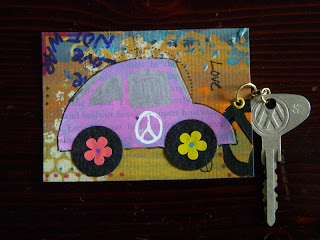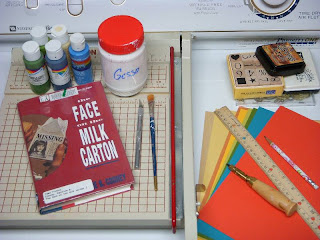Tag : ATC
45 posts
I started with an 8.5×11 sheet of periwinkle cardstock. With an old credit card, I spread out some orange and yellow craft paints.
After that was dry, I used rubber stamps, more paint, markers, and stencils to create lots of background interest.
When I was happy with it I cut 9 ATC’s from my full sheet of cardstock.
I free handed a VW bug to make a template then cut little bugs out of discarded book pages. Paint and marker were applied in a very loose manner.
I punched wheels from black “handmade paper” …I put that in quotes since it was actually store bought. I then used little flower sticker for some fun hubcaps.
The part that I love the most is the genuine VW key attached to each one. I grew up with tons of Volkswagons. My dad and his friend would buy them cheap, fix them up and resell. Sometimes they would just part them out. Dad never threw out anything so I had just enough VW keys laying around to give these ATC’s just a little extra punch!
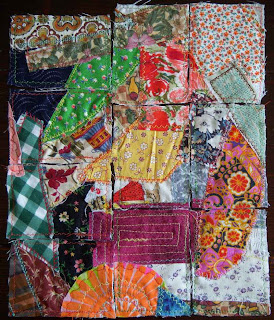 These are for an Anything but Paper ATC swap.
These are for an Anything but Paper ATC swap.
I took a scrap of old table cloth and started randomly sewing fabric scraps on using different colors of thread and stitches. It was fun playing with the different settings on my machine.
I took a ATC template and traced the proper sizes on the back then cut on the lines. I did a zigzag stitch around each to hold everything together.
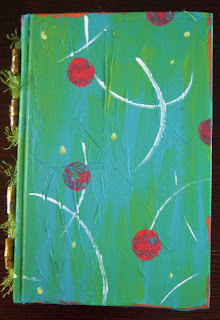 As requested by a few members of ABC I’ve taken pictures along the process of making my latest ATC book. I’ll do my best to explain the steps. Please click on the pictures for a better view of any step.
As requested by a few members of ABC I’ve taken pictures along the process of making my latest ATC book. I’ll do my best to explain the steps. Please click on the pictures for a better view of any step.
After being properly scolded by Elizabeth, here is the supply list:
- book large enough to fit your ATC’s
- x-acto knife or other cutting blade
- gesso
- pencil
- ruler
- cardstock
- cutting system such as guillotine or fiskars rotary cutter
- white glue or gel medium
- paint
- paint brush
- tissue paper or dress pattern(optional)
- rubber stamps(optional)
- ink pads(optional)
- Japanese screw punch or awl
- thread or fibers for binding
- large needle
- decorative beads(optional)
- something to protect your work surface
 The first step is to remove the text block from the cover. To do this you carefully cut along the spine on each side of the text block being careful not to cut through the cover. I used a glued in binding book so I had to use a bit of muscle to separate the glued in block after cutting. I reinforced the spine with a strip of cereal box cardboard adhered with gel medium although I’m sure white glue would work as well.
The first step is to remove the text block from the cover. To do this you carefully cut along the spine on each side of the text block being careful not to cut through the cover. I used a glued in binding book so I had to use a bit of muscle to separate the glued in block after cutting. I reinforced the spine with a strip of cereal box cardboard adhered with gel medium although I’m sure white glue would work as well.
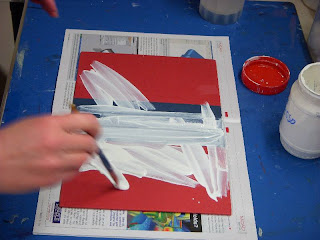 Next I coated both sides of the cover with gesso and set aside to dry.
Next I coated both sides of the cover with gesso and set aside to dry.
 In the meantime I measured the text block to determine the size of the cardstock that I’d be cutting.
In the meantime I measured the text block to determine the size of the cardstock that I’d be cutting.
 For my book, I cut 16 pieces to 3.75″ x 10″. This will eventually yield 4 signatures but now I’m getting ahead of myself.
For my book, I cut 16 pieces to 3.75″ x 10″. This will eventually yield 4 signatures but now I’m getting ahead of myself.
 My next step is purely personal preference. I randomly stamped both side of my pages for visual interest.
My next step is purely personal preference. I randomly stamped both side of my pages for visual interest.
 After folding in half, I used a bone folder (forgot that in the supply photo as well) to make a nice sharp fold.
After folding in half, I used a bone folder (forgot that in the supply photo as well) to make a nice sharp fold.
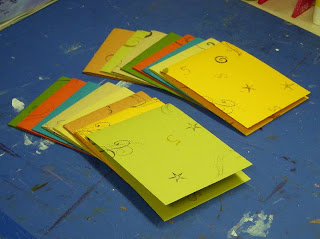 Completed pages ready to be gathered into signatures.
Completed pages ready to be gathered into signatures.
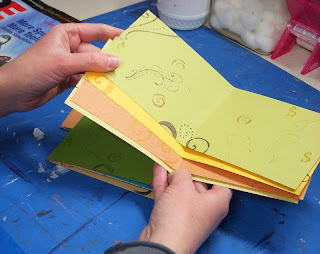 I used 4 pages for each of the 4 signatures…boy, that was a lot of fours!
I used 4 pages for each of the 4 signatures…boy, that was a lot of fours!
 At this point the gesso on the cover had dried and I was ready to make them pretty. I love using dress patterns for texture. As an added bonus it acts as a reinforcement. I simple spread out white glue and pat the pattern tissue gently down then set aside to dry.
At this point the gesso on the cover had dried and I was ready to make them pretty. I love using dress patterns for texture. As an added bonus it acts as a reinforcement. I simple spread out white glue and pat the pattern tissue gently down then set aside to dry.
 After it dried, I painted the inside.
After it dried, I painted the inside.
 Used the same technique on the outside with scraps of pattern tissue.
Used the same technique on the outside with scraps of pattern tissue.
 And again painted and set aside to dry.
And again painted and set aside to dry.
 While the cover was drying, I prepped the signatures for binding. I made a template from scrap cardstock as my guide for hole punching.
While the cover was drying, I prepped the signatures for binding. I made a template from scrap cardstock as my guide for hole punching.
 I used a Japanese screw punch for my holes. You could also use an awl. You just don’t want the holes too big. I’m using the smallest bit my screw punch came with. BTW-the hole gets plugged when cutting through multiple layers. I keep a needle near by to dig out the tiny little circles plugging the punch.
I used a Japanese screw punch for my holes. You could also use an awl. You just don’t want the holes too big. I’m using the smallest bit my screw punch came with. BTW-the hole gets plugged when cutting through multiple layers. I keep a needle near by to dig out the tiny little circles plugging the punch. I used my guide to make the holes in the book binding as well.
I used my guide to make the holes in the book binding as well.
 And punched 4 sets of 3 holes in the binding.
And punched 4 sets of 3 holes in the binding. I started with an 18 in fiber on a large needle in the center hole from the inside of the signature leaving yourself a 4 inch tail.
I started with an 18 in fiber on a large needle in the center hole from the inside of the signature leaving yourself a 4 inch tail.
 Go through the outside of the book cover, slip in a bead then go back through the top hole in the cover and signature.
Go through the outside of the book cover, slip in a bead then go back through the top hole in the cover and signature.
Next go back through the center hole to the outside, slip on a bead and then go back through the remaining hole of the set. It should then look like this. Take the needle and go under the complete flat loop then tie the loose ends tightly in a knot. You’ve just completed your first signature. Go back and do it 3 more times.
It should then look like this. Take the needle and go under the complete flat loop then tie the loose ends tightly in a knot. You’ve just completed your first signature. Go back and do it 3 more times.
The way I do the pamphlet stitch binding isn’t exactly that way the tutorials out there would have you do it but it’s the way I do. I’d encourage you to do a search and check out the other techniques if mine seems unclear. There are video tutorials out there as well.
 Completed book outside..in poor light.
Completed book outside..in poor light.
A few end notes…
- I made sure my book was large enough to accommodate ATC’s in portrait and landscape orientation.
- Be sure to leave at least 1/8 space between the 2 sections of pages so they actually turn.
- Keep in mind that you’ll the book will become twice it’s size or more once the ATC’s are loaded. I use photos corners to mount my ATC’s.

I was shocked to see I’m already at 300!
This ATC is made of items that would have been recycled anyway. My way has a little more visual appeal. I used a cereal box, a wallpaper sample and green magazine images. I decided to sew the wallpaper to the cereal box so I wouldn’t have to use glue. Of course I could have cut letters from the magazine to spell my message but a white gel pen was so much quicker.


I’ve been making and swapping quite a few ATC’s lately and am running out of room. I came up with the idea to use a book with the pages cut in half to house the books. I doggedly cut down through the pages and then at the end discovered that I had cut at an angle so the the pages wouldn’t turn independently. I was not giving up…
I cut out the text block and made my own signatures. I prepped and painted the cover inside and out before adding the signatures which I also randomly stamped for some interest.
The pages are big enough to place ATC’s in both a portrait and landscape orientation. This was very important to me. I have another book that I store ATC’s in that I have to turn each time there is a landscape one…drives me crazy.


